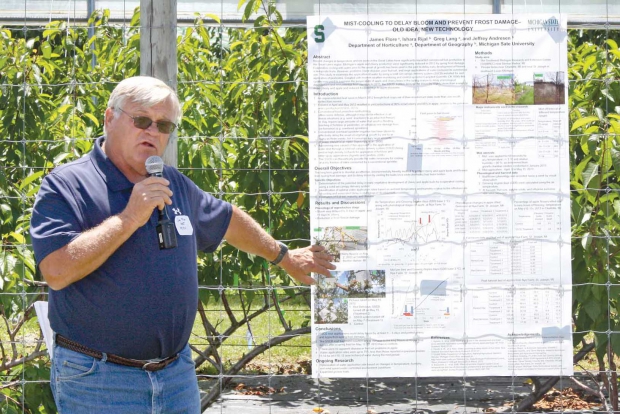
Dr. James Flore explains how calcium chloride sprays can reduce sweet cherry cracking during rainy weather at a field day at the Clarksville Research Station on July 10, 2014. (Richard Lehnert/Good Fruit Grower)
Dr. James Flore came into his work in a somewhat unusual way.
The young man from a fruit and vegetable farm in Bainbridge in southwest Michigan had taken all three of his degrees—bachelor’s, master’s, and doctorate—from Michigan State University and had been hired for an open position in the same horticulture department even before he graduated.
Between his master’s and doctorate, Flore served in the military. He returned to MSU in 1971 to complete his doctorate. Three years later, he was hired to fill a position made vacant by the death of Dr. Art Mitchell, a prominent professor of horticulture.
Flore took over Mitchell’s fruit extension work, plus he did research, teaching, and educational coordination for the Michigan State Horticultural Society and its annual show, now called Great Lakes Expo.
Flore is rightfully proud. MSU was the pioneer land grant university and had graduated, in 1882, the “father of modern horticulture,” Liberty Hyde Bailey. Flore joined a highly regarded department, where he had been mentored by Dr. John Bukovac, who is known worldwide for his work with plant growth regulators. Flore and Dr. Duane Greene, who went on to a distinguished career at the University of Massachusetts, overlapped as Bukovac’s graduate students.
Flore agrees it was the start of a grand era for tree fruit physiologists entering the research world. Many of them knew each other from college days, and they sorted out how they were all going to work together.
Flore saw his contemporaries Dr. Alan Lakso settle in at Cornell University and Greene at the University of Massachusetts, both working with apples, and Dr. Ted DeJong go to the University of California to work on peaches.
After getting his position at MSU to work with apples, Flore saw a niche in working with physiological limitations on yield in cherries, both sweet and tart. He asked department chairman, Dr. John Carew, to change his job description.
What his colleagues wanted to discover about peaches and apples, Flore wanted to know about cherries. In his early years, he characterized the effect of environmental and biological factors on photosynthesis and carbon partitioning in cherry. Over the years, their research programs were quite parallel and their discoveries reinforced each other and led to new research and new discoveries.
Early on, they created an informal group and agreed to set aside travel money to meet once a year to talk about their work and questions yet to be answered.
Earlier this year, Dr. Terence Robinson at Cornell University noted that these men are reaching the end of their careers, and he initiated a conference focusing on these researchers and their lives’ work.
Jim Flore was one of seven who presented at the conference at Cornell University in March, along with Lakso, Greene, DeJong, John Palmer from New Zealand, Scott Johnson from California, and Jim Syvertsen, a citrus researcher from Florida. They all knew each other very well. •






Leave A Comment